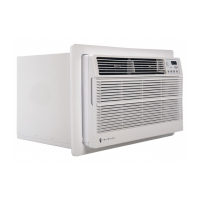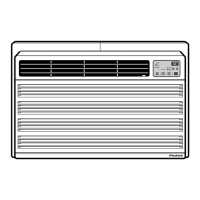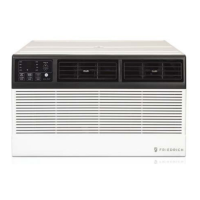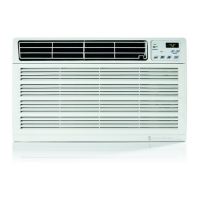22
M. TROUBLESHOOTING
M.1. Troubleshooting Tips
COMPLAINT CAUSE SOLUTION
Unit does not operate.
• The unit is turned to the off position, or
the thermostat is satised.
• Turn the unit to the on position and raise or lower temperature setting (as
appropriate) to call for operation.
• The LCDI power cord is unplugged.
• Plug into a properly grounded 3 prong receptacle. See “Electrical Rating Tables”
on Page 6 for the proper receptacle type for your unit.
• The LCDI power cord has tripped
(Reset button has popped out).
• Press and release RESET (Listen for click. Reset button latches and remains
in.) to resume operation.
• The circuit breaker has tripped or the
supply circuit fuse has blown.
• Reset the circuit breaker, or replace the fuse as applicable. If the problem
continues, contact a licensed electrician.
• There has been a local power failure. • The unit will resume normal operation once power has been restored.
Unit Trips Circuit Breaker
or
Blows Fuses.
• Other appliances are being used on the
same circuit.
• The unit requires a dedicated outlet circuit, not shared with other appliances.
• An extension cord is being used. • Do NOT use an extension cord with this or any other air conditioner.
• The circuit breaker or time-delay fuse is
not of the proper rating.
• Replace with a circuit breaker or time-delay fuse of the proper rating. See “Elec-
trical Rating Tables” on Page 6 for the proper circuit breaker/ fuse rating for your
unit. If the problem continues, contact a licensed electrician.
LCDI Power Cord Trips
(Reset Button Pops Out).
• The LCDI power cord can trip (Reset
button pops out) due to disturbances
on your power supply line.
• Press and release RESET (Listen for click. Reset button latches and remains in.)
to resume normal operation.
• Electrical overload, overheating, or cord
pinching can trip (Reset button pops
out) the LCDI power cord.
• Once the problem has been determined and corrected, press and release
RESET (Listen for click. Reset button latches and remains in.) to resume
normal operation.
NOTE: A damaged power supply cord must be replaced with a new power supply cord obtained from the product manufacturer and
must not be repaired.
Unit Does Not Cool Room
Sufciently, or Cycles On
And Off Too Frequently.
• The return/ discharge air grille is
blocked.
• Ensure that the return and/ or discharge air paths are not blocked by curtains,
blinds, furniture, etc.
• Windows or doors to the outside are
open.
• Ensure that all windows and doors are closed.
• The temperature is not set at a cool
enough enough setting.
• Adjust the Temperature control to a cooler or warmer setting as necessary.
• The lter is dirty or obstructed. • Clean the lter, (see Routine Maintenance), or remove obstruction.
• The indoor coil or outdoor coil is dirty or
obstructed.
• Clean the coils, (see Routine Maintenance), or remove obstruction.
• There is excessive heat or moisture
(cooking, showers, etc.) in the room.
• Be sure to use exhaust vent fans while cooking or bathing and, if possible, try not
to use heat producing appliances during the hottest part of the day.
• The temperature of the room you are
trying to cool is extremely hot.
• Allow additional time for the air conditioner to cool off a very hot room.
Unit Does Not Cool
Room Sufciently, or
Cycles On And Off Too
Frequently (continued).
• The outside temperature is below 60 °F
(16 °C).
• Do not try to operate your air conditioner in the cooling mode when the outside
temperature is below 60 °F (16 °C). The unit will not cool properly, and the unit
may be damaged.
• The digital control is set to fan cycling
mode.
• Since the fan does not circulate the room air continuously at this setting, the
room air does not mix as well and hot (or cold) spots may result. Using the con-
tinuous fan setting is recommended to obtain optimum comfort levels.
• The air conditioner has insufcient
cooling capacity to match the heat gain
of the room.
• Check the cooling capacity of your unit to ensure it is properly sized for the room
in which it is installed. Room air conditioners are not designed to cool multiple
rooms.
• The air conditioner has insufcient
heating capacity to match the heat loss
of the room.
• Check the heating capacity of your unit. Air conditioners are sized to meet the cooling
load, and heater size is then selected to meet the heating load. In extreme northern
climates, room air conditioners may not be able to be used as a primary source of
heat.
